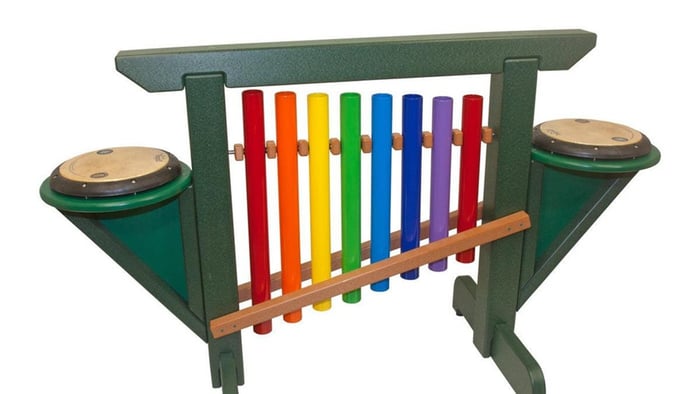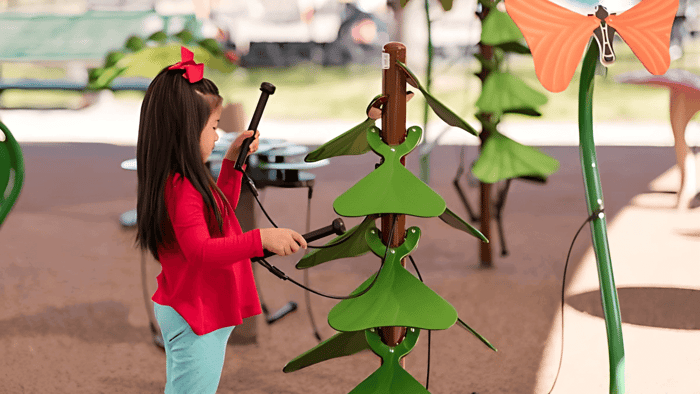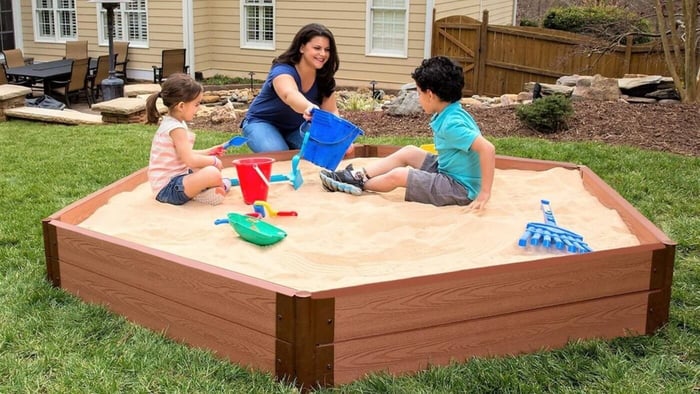
Best Sandbox Material: Wood vs Composite vs Plastic
Table of Contents
- Which material is best for your outdoor sandbox —plastic, composite, or wood? Plastic sandboxes last 50+ years with almost no upkeep, composite sandboxes offer a natural look and last 25–30 years, while wooden sandboxes provide classic charm but need yearly care and last about 10–15 years.
- Key Takeaways:
- Durability Champion: Which Sandbox Material Lasts Longest in the Elements?
- Material Breakdown: Lifespan Comparison of Wood, Composite, and Plastic Sandboxes
- Critical Factors Affecting Outdoor Sandbox Longevity
- Maintenance Requirements Across Materials
- Safety Considerations for Different Sandbox Materials
- Long-Term Value: Why Initial Cost Doesn't Tell the Full Story
- The Verdict: Which Sandbox Material Offers the Best Return on Investment
- In Summary
- FAQs
Which material is best for your outdoor sandbox —plastic, composite, or wood? Plastic sandboxes last 50+ years with almost no upkeep, composite sandboxes offer a natural look and last 25–30 years, while wooden sandboxes provide classic charm but need yearly care and last about 10–15 years.
Key Takeaways:
- Plastic sandboxes are the most weather-resistant option, lasting 50+ years with minimal maintenance requirements, making them ideal for wet climates.
- Composite wood sandboxes balance durability and natural appearance, with a typical lifespan of 25-30 years and resistance to rot, insects, and splintering.
- Traditional wood sandboxes have natural appeal but require annual maintenance and typically last 10-15 years before showing significant weathering or damage.
- Environmental factors like UV exposure, moisture, and temperature fluctuations significantly impact sandbox longevity regardless of material.
- Little People's Cove offers a wide selection of durable sandbox options designed to withstand outdoor conditions while providing a safe play environment for children.
Durability Champion: Which Sandbox Material Lasts Longest in the Elements?
When it comes to creating the perfect outdoor play space for your little ones, durability matters just as much as fun. Sandbox materials vary dramatically in how they withstand the elements, with each option presenting its own unique balance of longevity, maintenance needs, and aesthetic appeal.
The battle between wood, composite, and plastic sandbox materials ultimately comes down to how well each can endure years of both playtime and exposure to Mother Nature's challenges. From scorching summer sun to winter freezes, from persistent rain to daily wear and tear, your choice of material will determine whether your sandbox remains a backyard staple for years or decades to come.
I've researched how each material performs over time, so you can make an investment that will withstand countless sandcastles and imaginative adventures. Little People's Cove specializes in durable sandbox options designed to withstand the test of time while providing a safe, fun environment for children's play.
Material Breakdown: Lifespan Comparison of Wood, Composite, and Plastic Sandboxes
Traditional Wood Sandboxes: Natural Appeal with 10-15 Year Lifespan
Wood sandboxes remain popular for their natural aesthetics and classic playground feel. Typically crafted from cedar or redwood, these sandboxes blend beautifully with outdoor landscapes and offer a traditional look many parents prefer. However, their organic origins also make them more vulnerable to environmental damage.
The average lifespan of a well-maintained wooden sandbox ranges from 10-15 years, with untreated varieties potentially showing signs of wear much sooner. Exposure to moisture is particularly problematic, causing warping, splitting, and rot over time. While pressure-treated lumber can extend the sandbox's life, some parents have concerns about chemical treatments coming into contact with children's play areas.
Wood's greatest enemy is neglect—without regular maintenance, even high-quality wooden sandboxes will deteriorate rapidly when exposed to the elements. The natural appeal comes with a commitment to ongoing care that some families may find challenging to maintain over the years.
Key properties of wood sandboxes:
- Natural aesthetic that blends with landscape
- 10-15 year lifespan with proper maintenance
- Requires annual sealing or staining
- Vulnerable to moisture damage and insect infestation
- Can develop splinters as it ages
- Generally lower initial cost compared to alternatives
Square Wood Sandbox with Rotatable Canopy Cover

$239.99
Bring playtime outside with Teamson Kids' 4' Square Sandbox! This solid wood Square Wood Sandbox with Rotatable Canopy Cover is painted with a cobalt blue water...… read more
Composite Wood Sandboxes: The 25-30 Year Middle-Ground Solution
Composite wood sandboxes represent a significant evolution in outdoor play equipment, blending the aesthetic appeal of natural wood with enhanced durability. These sandboxes are manufactured using a mixture of wood fibers (typically 50-70%) and recycled plastic polymers (30-50%), creating a material that mimics the look of wood while addressing many of its vulnerabilities.
With a typical lifespan of 25-30 years, composite wood significantly outperforms traditional lumber in durability tests. This material resists many of the issues that plague wooden sandboxes—it won't rot when exposed to moisture, remains impervious to insect damage, and doesn't splinter as it ages. For parents, this last point is particularly valuable, eliminating a common safety concern associated with traditional wooden play equipment.
The maintenance requirements for composite sandboxes are minimal compared to wood. They don't require annual sealing or staining, and can typically be cleaned with simple soap and water once or twice a year. While the initial investment is higher than traditional wood, the extended lifespan and reduced maintenance needs often make composite the more economical choice over time.
Key properties of composite wood sandboxes:
- 25-30 year average lifespan
- Resists rot, warping, and insect damage
- Won't splinter, reducing injury risks
- Minimal maintenance requirements (occasional cleaning)
- Environmentally friendly when made from recycled materials
- Natural wood appearance with enhanced durability
- Moderate weight - heavier than plastic but lighter than solid wood
Hexagon Sandbox with Telescoping Canopy & Cover - 7' x 8' x 11"

$483.39
Introducing the Frame It All Hexagon Sandbox with Telescoping Canopy & Cover in the size of 7' x 8' x 11. This spacious and durable...… read more
Plastic Sandboxes: The 50+ Year Weather-Resistant Option
Plastic sandboxes represent the ultimate in weather resistance and longevity in the outdoor play equipment market. Constructed from high-density polyethylene (HDPE) or similar materials engineered with UV inhibitors, quality plastic sandboxes can last an impressive 50 years or more—often outlasting the childhood of multiple generations in a family.
The secret to plastic's extraordinary durability lies in its complete resistance to moisture-related problems. Unlike wood or even composite materials, high-quality plastic won't absorb water, eliminating concerns about rot, mold, or structural weakening. Modern plastic sandboxes are also engineered with UV-resistant formulations that prevent the material from becoming brittle or fading significantly over years of sun exposure.
Maintenance for plastic sandboxes is remarkably simple—occasional rinsing with a garden hose every few months is typically all that's required to keep them clean and inviting. For families in particularly wet or humid climates, plastic represents the most practical choice, as it can withstand even the most challenging weather conditions without degradation.
Key properties of plastic sandboxes:
- 50+ year potential lifespan
- Complete immunity to rot, mold, and insects
- Minimal maintenance (simple rinsing)
- Lightweight and easy to reposition
- Available in various colors and designs
- Resistant to cracking and splitting
- Often includes integrated features like covers and seating
- Ideal for wet and humid climates
Sandlock Plastic Sandbox with Cover 5' x 10'
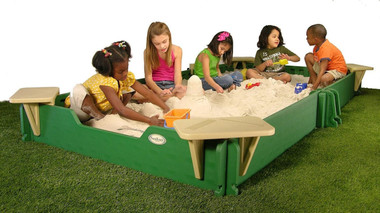
$689.00
The Sandlock Plastic Sandbox with Cover 5' x 10' is a durable and spacious sandbox perfect for outdoor play. This sandbox kit includes a 5'...… read more
Critical Factors Affecting Outdoor Sandbox Longevity
1. Environmental Exposure (UV, Temperature, Humidity)
The environment where your sandbox is placed plays a crucial role in determining its lifespan, regardless of material. Ultraviolet (UV) radiation from sunlight is particularly damaging, causing molecular breakdown that leads to color fading, surface degradation, and eventual structural weakening. Plastic materials can become brittle and crack, while wood fibers break down more rapidly when continuously exposed to intense sunlight.
Temperature fluctuations create their own challenges through expansion and contraction cycles. Materials expand in heat and contract in cold, and these repeated cycles can lead to warping, cracking, or loosening of fasteners over time. This is especially problematic in climates with extreme seasonal variations where temperatures might range from below freezing to over 100°F.
Humidity levels influence how quickly materials deteriorate as well. High humidity accelerates rot and mold growth in wooden sandboxes and can even affect composite materials over extended periods. In contrast, extremely dry conditions can cause wood to crack and split as moisture content fluctuates dramatically.
To mitigate environmental damage, consider placing your sandbox in a location that receives partial shade during the hottest part of the day. You might also invest in a quality cover or canopy to provide protection when the sandbox isn't in use.
2. Moisture Resistance and Drainage Capabilities
Moisture is perhaps the most significant threat to sandbox durability, making resistance to water damage a critical factor in material selection. When water becomes trapped in or around sandbox materials, it accelerates degradation through rot, rust of fasteners, and promotion of mold or mildew growth.
Plastic sandboxes excel in this area, as they're completely impervious to water absorption. Quality plastic won't swell, warp, or develop mold even after years of exposure to rain and snow. Composite materials perform nearly as well, with their plastic components providing significant protection against moisture damage. Traditional wood performs poorest in this category, requiring regular treatments to maintain water resistance.
For any sandbox type, consider these drainage improvements:
- Install a geotextile fabric liner beneath the sand to allow water passage while keeping sand clean
- Create a 2-3 inch layer of pea gravel beneath the sand for improved drainage
- Ensure the sandbox is elevated slightly above surrounding ground level
- Drill small drainage holes in plastic sandbox bottoms if they don't already exist
3. Material Composition and Structural Design
The specific composition of materials used in sandbox construction dramatically impacts longevity. Not all plastics or composites are created equal – the density, manufacturing process, and specific chemical formulations all influence how well they withstand environmental challenges.
High-density polyethylene (HDPE) is the gold standard for plastic sandboxes, offering superior strength and UV resistance compared to lower-density alternatives. For composites, the ratio of wood to plastic matters significantly – higher plastic content generally results in better moisture resistance but may sacrifice some of the natural appearance.
Structural design plays an equally important role in durability. Features like reinforced corners, quality fasteners, and proper wall thickness distribute weight and pressure evenly, preventing premature failures. The most durable sandboxes incorporate designs that accommodate natural expansion and contraction without compromising structural integrity.
4. Installation Method and Location Considerations
Even the most durable sandbox materials can fail prematurely if installed incorrectly or placed in an unsuitable location. Proper installation creates a stable foundation that prevents shifting, sinking, or warping over time.
For ground contact, it's essential to create a level base, typically using sand, gravel, or concrete depending on the sandbox design. Some models include ground anchors or stakes to prevent movement during use or in strong winds. Composite and wooden sandboxes particularly benefit from being installed slightly above ground level to minimize direct soil contact.
Location selection significantly impacts longevity as well. Areas with proper drainage that don't accumulate standing water will extend the life of any sandbox. Partial shade is ideal – enough sun to keep the sand dry after rain, but not so much that materials are constantly subjected to intense UV exposure. Consider prevailing winds too, as constant exposure to wind-driven rain or sand can accelerate wear.
Maintenance Requirements Across Materials
1. Wood Sandbox Upkeep: Annual Sealing and Regular Inspections
Wooden sandboxes demand the most rigorous maintenance schedule to achieve their potential lifespan.
Essential wood sandbox maintenance steps:
- Apply water-resistant sealant or child-safe stain annually (spring is ideal)
- Inspect quarterly for splinters, sanding rough areas as needed
- Check and tighten all fasteners at least twice yearly
- Clean visible mold or mildew immediately with appropriate wood cleaners
- Replace any boards showing signs of rot or severe cracking
- Keep the sandbox covered when not in use to minimize moisture exposure
- Remove wet leaves and debris promptly to prevent staining and decay
2. Composite Maintenance: Occasional Cleaning and Minor Repairs
Composite sandboxes strike a middle ground in maintenance requirements, needing significantly less attention than wood but still benefiting from periodic care.
Composite sandbox maintenance routine:
- Clean surfaces with mild soap and water 1-2 times per year
- Inspect connections and fasteners annually, tightening as needed
- Check for any deep scratches or gouges that might need filling
- Remove any stains promptly with composite-safe cleaners
- Ensure drainage remains clear and functional
- Use a soft brush to remove any algae growth in shaded areas
3. Plastic Sandbox Care: Simple Rinsing and Minimal Attention
Plastic sandboxes truly shine when it comes to maintenance simplicity. These virtually maintenance-free options require little more than occasional cleaning to remain in excellent condition for decades.
Plastic sandbox care basics:
- Rinse with water 2-3 times per year to remove dirt and debris
- Inspect for any cracks or damage annually
- Check that drainage holes remain clear
- Use mild soap for stubborn stains or buildup
- Verify that cover or canopy remains in good condition
- Ensure anchoring system remains secure, especially after severe weather
Safety Considerations for Different Sandbox Materials
Beyond durability, safety remains a paramount concern when selecting sandbox materials for children's play areas. Each material presents its own unique safety profile that parents should consider alongside longevity factors.
Wood sandboxes, particularly those made from untreated lumber, can develop splinters over time that pose injury risks to children. Regular sanding of rough spots and thorough inspection before play can mitigate this concern. Some pressure-treated woods also raise questions about chemical exposure, making it essential to verify that any treatments used are specifically rated safe for children's play equipment.
Composite materials generally excel in safety considerations. They resist splintering, don't leach chemicals, and maintain their structural integrity well over time. Their smooth surfaces are comfortable for children to sit on and less likely to cause minor injuries during active play.
Plastic sandboxes are generally considered the safest option from an injury-prevention standpoint. Their smooth, rounded edges and splinter-free construction minimize common playground injuries. However, some plastic models can become quite hot when placed in direct sunlight, potentially causing discomfort or even minor burns on hot days. This concern can be addressed through shade structures or by selecting lighter-colored plastics that absorb less heat.
Long-Term Value: Why Initial Cost Doesn't Tell the Full Story
When evaluating sandbox options, looking beyond the price tag reveals important insights about true long-term value. The initial purchase price represents only one component of the total ownership cost over a sandbox's usable life.
Wooden sandboxes typically offer the lowest entry price, making them appealing to budget-conscious buyers. However, when factoring in ongoing maintenance costs—sealants, stains, replacement parts for rotted sections—and the shorter overall lifespan, wood often becomes the most expensive option per year of use.
Composite sandboxes present a middle-ground investment. Their higher initial cost is offset by minimal maintenance requirements and extended lifespan. When calculated on a cost-per-year basis over their 25-30 year lifespan, quality composite sandboxes often deliver better value than wood, particularly for families planning to remain in the same home for many years.
Plastic sandboxes frequently have the highest upfront cost but offer exceptional long-term value. Their minimal maintenance needs and potential 50+ year lifespan result in the lowest annual cost of ownership. For many families, the combination of durability, safety features, and maintenance simplicity justifies the higher initial investment.
Hexagon Sandbox Kit w/ Telescoping Canopy & Cover - 7' x 8' x 5.5"
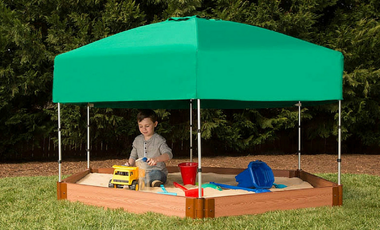
$362.54
The Frame It All Composite Hexagon Sandbox Kit 7ft. X 8ft. X 5.5 in. (2 inch profile) provides the building blocks of childhood imagination and...… read more
The Verdict: Which Sandbox Material Offers the Best Return on Investment
After analyzing durability, maintenance requirements, safety considerations, and long-term value, each sandbox material shows distinct advantages for different priorities and situations:
Plastic sandboxes excel in maximum longevity and minimum maintenance, making them ideal for families seeking a truly long-term solution, particularly in challenging climates with high rainfall or humidity.
Composite wood sandboxes provide an excellent balance of natural aesthetics and enhanced durability, perfect for those who appreciate wood's appearance but want significantly better performance and lower maintenance requirements.
Traditional wood sandboxes offer natural beauty and lower initial cost, suitable for temporary installations or when budget constraints make upfront price the primary consideration.
In Summary
| Feature | Wooden Sandbox | Plastic Sandbox | Composite Wood Sandbox |
| Durability | High with maintenance | High for heavy-duty plastics | Very high, resistant to rot and warping |
| Weather Resistance | Good with routine sealing | Very high, no sealing needed | Excellent, resists moisture and insects |
| Maintenance | Requires staining/sealing | Simple cleaning | Low maintenance, occasional rinse |
| Lifespan | 5–10+ years (with care) | 3–10+ years | 20–30+ years |
| Risk of Splinters | Possible, especially if untreated | None | None |
| Looks/Natural Appeal | Blends into yard, traditional | Varied shapes, less natural | Natural wood look with modern finish |
| Ease of Movement | Usually heavy, hard to move | Lightweight, easy to move | Heavy and sturdy, semi-permanent placement |
| Price Range | Moderate to high | Low to high, depending on build | High, premium option |
Your ideal sandbox choice ultimately depends on your specific circumstances—climate conditions, aesthetic preferences, maintenance willingness, and how long you plan to use the sandbox. Little People's Cove offers high-quality sandboxes across all three materials to help you find the perfect balance of durability, safety, and value for your family’s outdoor sandbox play space.
FAQs
Which sandbox material lasts the longest outdoors: wood, composite, or plastic?
Plastic sandboxes are the most durable, with lifespans of 50+ years and minimal maintenance required. Composite options balance natural aesthetics with longevity—lasting around 25–30 years while resisting rot, insects, and splintering. Traditional wood sandboxes offer a classic appeal but typically last only 10–15 years and demand annual maintenance like sealing and inspections.
What are the maintenance needs for wood, composite, and plastic sandboxes?
- Wood: Needs regular care—annual sealing, protection from splinters, and close inspection to prevent weather-related damage.
- Composite: Low maintenance; typically requires only occasional cleaning and minor repairs as needed.
- Plastic: Easiest to care for—just a rinse now and then, with virtually no upkeep needed.
How do I choose the best sandbox material considering safety and value?
If longevity and minimal upkeep are your top priorities, plastic is the best investment—ideal for wet or harsh climates. If you want a natural, stylish look with solid durability, composite offers a middle ground. For a traditional, rustic aesthetic—and if you're okay with regular maintenance—wood can still be a good choice. Overall, plastic usually delivers the best return on investment due to its extreme durability and weather resistance.


